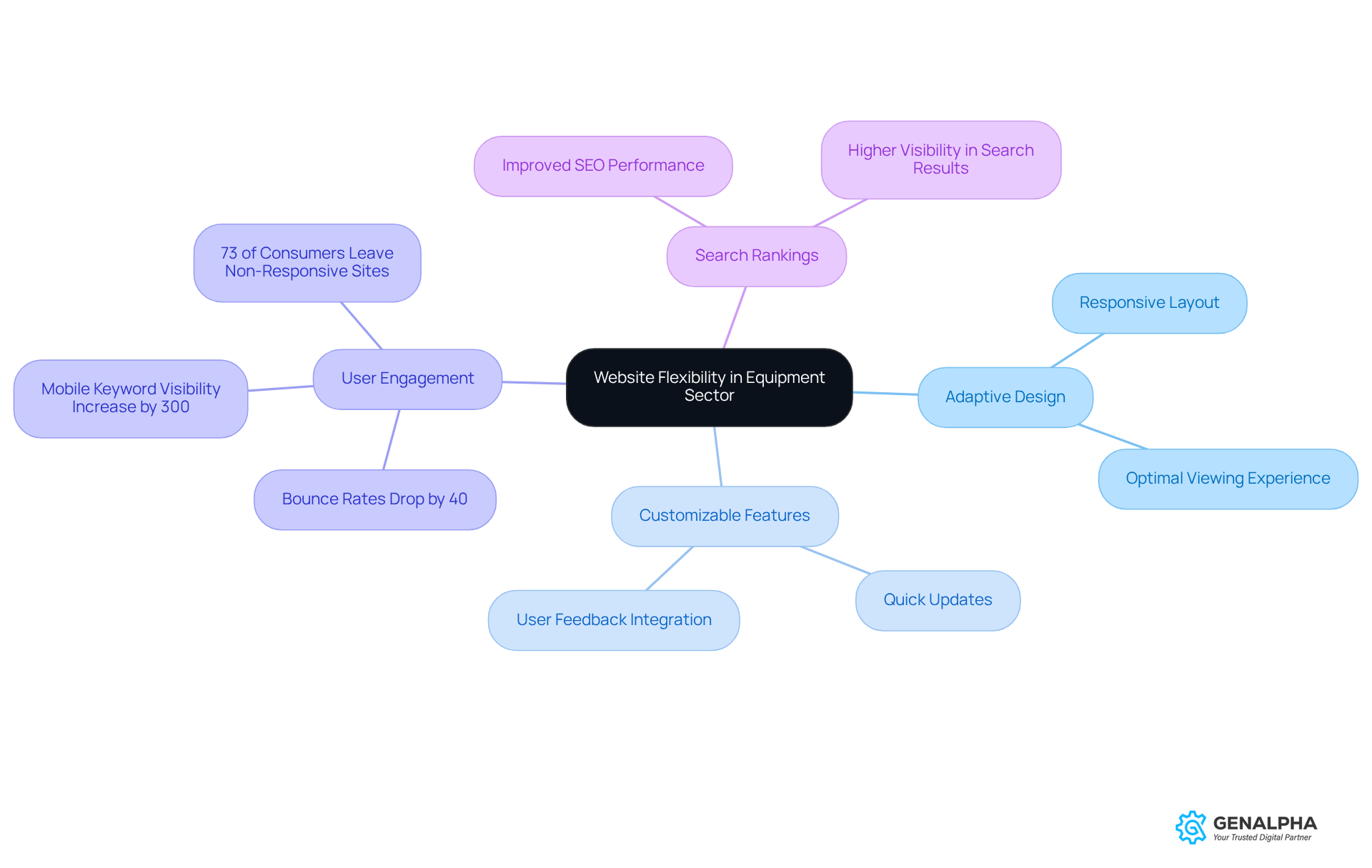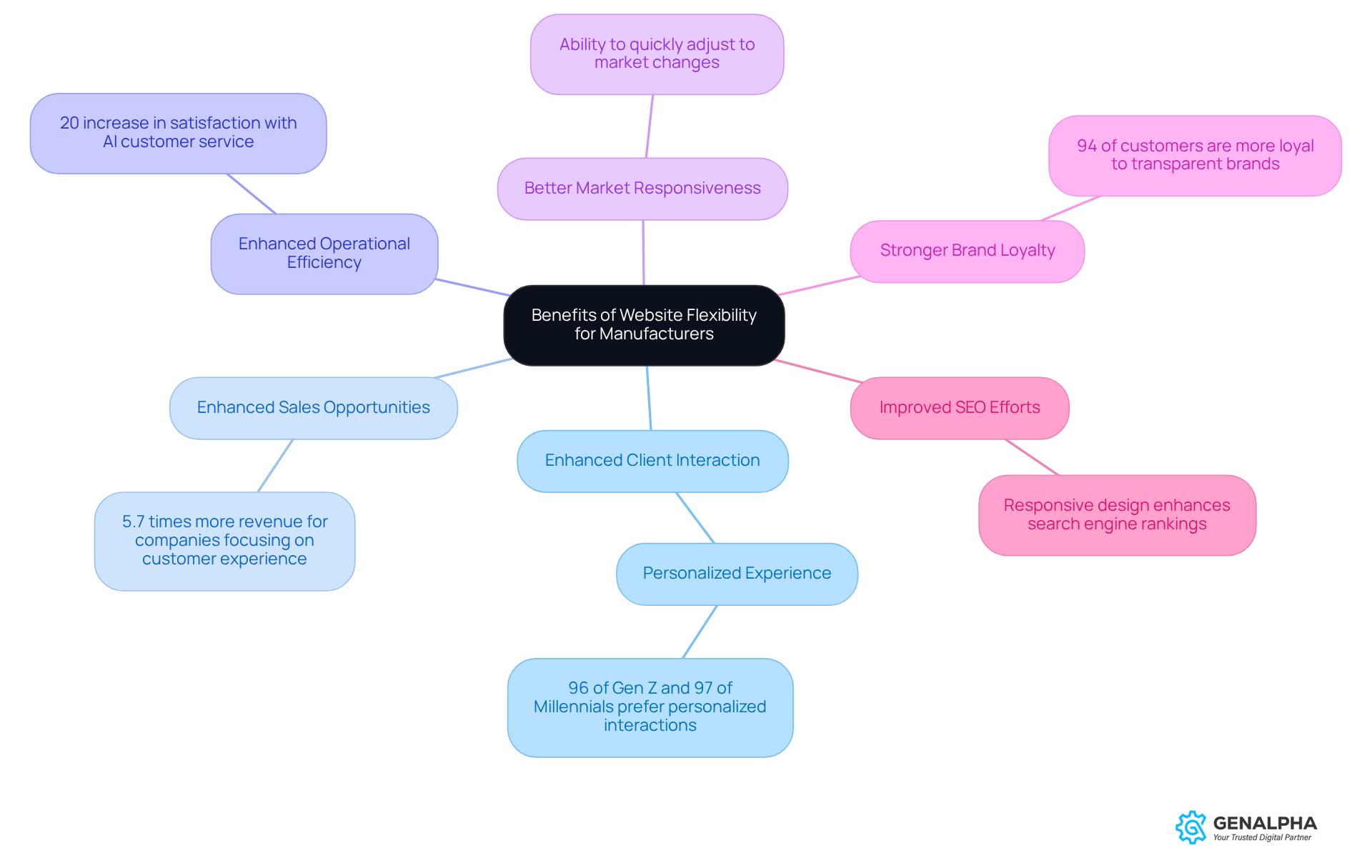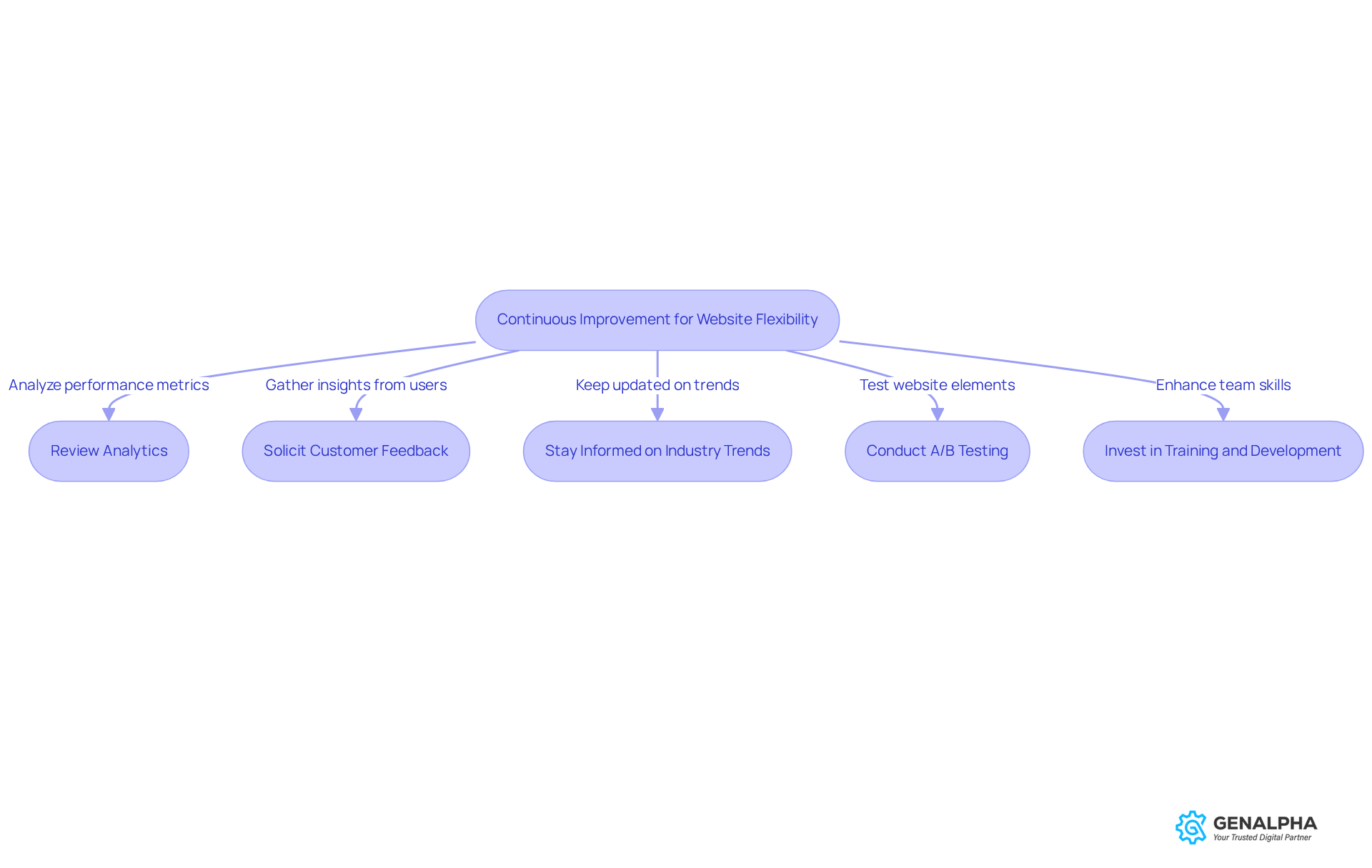Overview
Have you ever thought about how important it is for equipment manufacturers to have a flexible website? Well, it turns out that adopting responsive design and modular elements can be a game-changer! By leveraging analytics and enhancing client interaction features, you can significantly boost user engagement and operational efficiency.
Imagine how much easier it would be for your customers to navigate your site and find what they need. This not only leads to increased sales but also fosters customer loyalty. So, why not take the plunge? Start implementing these best practices today and watch your online presence transform!
Introduction
The digital landscape is constantly changing, and for equipment manufacturers, having a flexible website isn’t just a nice-to-have—it’s essential. With consumer expectations evolving and mobile usage on the rise, adapting online platforms is key to staying competitive and improving user experience.
So, how can manufacturers transform their digital presence? This article dives into the best practices for maximizing website flexibility. We’ll explore strategies that can turn a static site into a dynamic, responsive tool that meets the demands of today’s market.
Are you ready to ensure your digital presence not only keeps up with the pace of change but also thrives in this fast-paced environment?
Define Website Flexibility in the Equipment Sector
The concept of website flexibility revolves around how effectively a digital platform can adapt to various needs and the constantly evolving market. For equipment producers, this adaptability is crucial. It allows platforms to easily adjust to shifts in product offerings, integrate new technologies, and maintain a consistent user experience across all devices.
So, what makes a website flexible? Think adaptive design, which ensures that everything looks great on any screen size, and customizable features that allow for quick updates based on user feedback or industry trends. With over 60% of web traffic coming from mobile devices, having a isn't just a nice-to-have; it's essential for staying competitive.
Producers need to make sure their digital platforms can keep up with what clients expect, offering relevant information and services at all times. For example, companies that have embraced responsive design have seen impressive results—user engagement has soared, with bounce rates dropping by as much as 40% and mobile keyword visibility skyrocketing by 300% within just weeks of implementation.
Lower bounce rates and higher engagement from adaptive sites can lead to better search result rankings, making it easier for potential customers to find and connect with their offerings. And let’s not forget that a staggering 73% of consumers have left a site due to non-responsive design, underscoring just how vital responsive design is.
Ultimately, embracing website flexibility is a smart move that helps manufacturers thrive in a fast-paced digital marketplace. As Alyssa DiLascio puts it, "Responsive design is no longer a luxury, but a necessity for businesses that want to thrive in the highly competitive online landscape." So, are you ready to make your website more flexible and responsive?

Implement Key Strategies for Enhanced Website Flexibility
If you're looking to boost your website's flexibility, here are some strategies that might just do the trick:
- Adopt a Responsive Design: Have you ever tried to browse a website on your phone, only to find it a frustrating experience? Ensuring your online platform is mobile-friendly is key. With over 60% of online visitors starting their searches on mobile devices, a is essential for connecting with customers who are researching and shopping on their smartphones and tablets.
- Utilize Modular Design Elements: Think about how easy it would be to make updates without having to redo everything. By implementing a modular approach to your website design, you can easily add or remove widgets or plugins as needed. This website flexibility allows you to respond quickly to market demands and client preferences.
- Integrate Advanced Analytics: Ever wondered how you can better understand your audience? By utilizing analytics tools, you can observe individual behaviors and preferences. This data can guide necessary adjustments to your website, enhancing user experience and engagement. For example, companies that effectively leverage analytics often see significant boosts in conversion rates by tailoring their offerings based on real-time insights.
- Streamline Content Management: How often do you find outdated information on a website? Investing in a robust content management system (CMS) can help you make quick updates and create content easily. Keeping product details, promotions, and resources current is vital for maintaining consumer interest and trust.
- Enhance Client Interaction Features: Have you ever had a question and wished for a quick answer? Incorporating chatbots, feedback forms, and live chat options can facilitate real-time communication with clients. This ability to respond promptly can greatly enhance satisfaction and retention, as people appreciate swift answers to their inquiries.

Explore the Benefits of Website Flexibility for Manufacturers
Website adaptability brings a ton of benefits for manufacturers in the equipment industry, making users happier and boosting sales.
- Enhanced Client Interaction: Imagine a platform that molds itself to your preferences, creating a personalized and engaging experience. That’s what a versatile website does! Almost 96% of Gen Z and 97% of Millennials are more likely to keep buying from platforms that offer customized interactions. This really highlights how important personalization is for keeping younger buyers around.
- Enhanced Sales Opportunities: Keeping your online platform fresh and user-friendly is key. It helps manufacturers capture leads and turn them into sales. Research shows that companies focusing on customer experience can rake in up to 5.7 times more revenue than their competitors. This clearly shows how a responsive online presence can directly impact sales conversion rates.
- Enhanced Operational Efficiency: Adaptable platforms make updating and maintaining your site a breeze, saving time and resources. This efficiency allows manufacturers to focus on what they do best, ultimately boosting productivity. For instance, companies using AI for customer service report a 20% increase in satisfaction thanks to quicker issue resolution. It’s a perfect example of how technology can enhance operational efficiency and site adaptability.
- Better market responsiveness is facilitated by website flexibility, allowing manufacturers to quickly adjust to market changes, client feedback, and new trends. This agility keeps them competitive and relevant in a fast-paced world, allowing them to respond effectively to what clients really want.
- Stronger Brand Loyalty: A great online experience builds trust and loyalty among customers, encouraging them to come back for more and refer others. Transparency in operations and client interactions has been shown to boost loyalty, with 94% of clients saying they’re more loyal to brands that are open about their policies and practices.
- Improved SEO Efforts: Search engines love responsive designs, which helps enhance visibility and user engagement. This aspect of online adaptability not only improves user satisfaction but also helps in achieving better search engine rankings, driving more traffic and potential sales.
In summary, embracing flexible online design doesn’t just enhance customer experience; it also leads to increased sales and stronger brand loyalty for equipment manufacturers. So, why not take the plunge and see the difference it can make?

Evaluate and Adapt: Continuous Improvement in Website Flexibility
To ensure your website flexibility and responsiveness, let’s consider a . It’s all about making small, consistent changes that add up over time. Here are some friendly tips to get you started:
- Regularly Review Analytics: Have you taken a good look at your online performance metrics lately? By continuously analyzing these numbers, you can spot trends, understand user behavior, and identify areas that could use a little TLC.
- Solicit Customer Feedback: Why not ask your customers directly about their online experience? Gathering feedback through surveys, forms, or even casual conversations can provide valuable insights that help you improve.
- Stay Informed on Industry Trends: It’s crucial to keep your finger on the pulse of technological advancements and industry best practices. This way, your platform stays competitive and relevant in an ever-changing market.
- Conduct A/B Testing: Testing is key! Try out different website elements—layouts, content, features—to see what resonates best with your users. This approach helps you optimize based on real feedback.
- Invest in Training and Development: Finally, make sure your team is equipped with the latest digital tools and strategies. A well-trained team can implement changes effectively, making your website even better.
By embracing these strategies, you’re not just enhancing your website flexibility; you’re also improving the experience for your users. So, what are you waiting for? Let’s get started on this journey together!

Conclusion
When we talk about website flexibility in the equipment manufacturing sector, it’s clear just how vital it is for companies to adapt their digital platforms to keep up with changing market demands. A flexible website doesn’t just improve user experience; it also helps manufacturers stay competitive in today’s digital world. This kind of adaptability is key to meeting customer expectations and staying relevant in a fast-paced environment.
Throughout this article, we’ve explored several key strategies to boost website flexibility. Think about adopting:
- Responsive design
- Utilizing modular elements
- Integrating advanced analytics
- Streamlining content management
- Enhancing client interaction features
Each of these strategies plays a part in creating a more engaging and efficient online experience, which can lead to happier clients, more sales opportunities, and improved operational efficiency. The perks of such flexibility go beyond just immediate user engagement; they help build brand loyalty and improve search engine visibility too.
So, as we wrap up, remember that the journey toward a more flexible website isn’t merely a technical upgrade; it’s a strategic must for equipment manufacturers who want to thrive. By focusing on adaptability and continuously refining their digital presence, manufacturers can better meet their clients’ needs and seize new opportunities in the market. Embracing these best practices will not only elevate customer experiences but also drive sustainable growth in this ever-evolving industry. Are you ready to take the leap?
Frequently Asked Questions
What is website flexibility in the equipment sector?
Website flexibility refers to how effectively a digital platform can adapt to various needs and the evolving market, allowing equipment producers to adjust to shifts in product offerings, integrate new technologies, and maintain a consistent user experience across all devices.
What are the key components of a flexible website?
Key components of a flexible website include adaptive design, which ensures optimal appearance on any screen size, and customizable features that allow for quick updates based on user feedback or industry trends.
Why is responsive design important for websites?
Responsive design is important because over 60% of web traffic comes from mobile devices. It is essential for staying competitive and meeting client expectations by providing relevant information and services at all times.
What benefits have companies seen from implementing responsive design?
Companies that have embraced responsive design have experienced significant benefits, including increased user engagement, reduced bounce rates by up to 40%, and a 300% increase in mobile keyword visibility shortly after implementation.
How does website flexibility impact search rankings?
Lower bounce rates and higher engagement from adaptive sites can lead to better search result rankings, making it easier for potential customers to find and connect with offerings.
What is the consequence of non-responsive design for consumers?
A staggering 73% of consumers have left a site due to non-responsive design, highlighting the critical importance of having a responsive website.
Why should manufacturers prioritize website flexibility?
Embracing website flexibility is a smart move for manufacturers as it helps them thrive in a fast-paced digital marketplace, ensuring they remain competitive and meet customer expectations.




